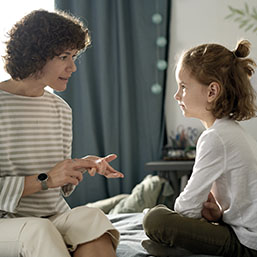
The start of summer break often brings a sense of excitement and relief. Every child’s summer looks a little different. Some attend camps, others go on family vacations, and many spend more time outdoors. For some, it’s simply a chance to unwind without structure or expectations.
\n \nSchool pressures seem to vanish – that is, until August hits. Suddenly, department stores are filled with back-to-school displays. Caregivers start thinking about the upcoming school year and everything it entails. For many children, this shift can trigger anxiety. Common signs may include: bedtime rumination (your child may have a harder time falling asleep than usual); frequent reassurance seeking (“Do you think Maddy will be in my class this year?”; “Do you think I’ll like my teacher?”); increased irritability, and negative self-talk (“I’m not smart. I’m going to fail this year.”)
\nIf you notice any of these signs, it’s a good time to check in. Keep in mind that some children internalize anxiety, so symptoms may be more subtle or difficult to detect. Even if none of the signs above are present, conducting a mental health check-in a week or two before school starts can still be a valuable and proactive step to help your child feel more prepared.
\nSo, what can a check-in look like? That depends on your child and your family. You might opt for a structured approach or keep things more informal.
\nA structured check-in might involve sitting down together and asking direct questions or using conversation cards. Sample questions include:
\nAn informal check-in may happen more organically while driving, eating together, or during bedtime routines. You can ask similar questions and observe their responses. This approach often works well with preteens and teenagers, who may open up more in relaxed settings.
\nOnce you’ve identified possible anxiety triggers, you can start building awareness and problem-solving strategies together. Common back-to-school triggers include:
\nAfter identifying triggers, here are some helpful strategies to reduce back-to-school anxiety:
\nRemember, back-to-school anxiety is a completely normal experience for many children. By acknowledging it early and supporting them with care and curiosity, you can help set the stage for a more confident and connected start to the year.
\n\n
Joanna and Lara (Registered Psychologist and Child Mental Health Advocate) started Psyched About Kids (PAK) in 2016 because they are obsessed with human potential! PAK empowers parents with science-backed knowledge, strategies and tools to solve our most pressing parenting issues today and make life a little easier, along with ongoing support to implement the desired change. Small actions over time can have an unimaginable impact on child growth and development for lifelong health and wellness. Learn more at psychedaboutkids.com.
\n\n
See our related articles:
\n
Calgary’s Child Magazine © 2025 Calgary’s Child